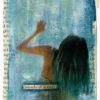Fran Bull
Self-Portrait as a Black Woman
mixed media on canvas
30 x 24 in.
My painting, Self-portrait as a Black Woman was banned from the show “She Persisted” (Soho20 Bushwick, April 21-May 20). I was informed on April 21 by the Board of directors, that the subject of the art was too inflammatory and controversial. It was suggested to me that showing the piece could have serious consequences for the organization. I argued, “but this is what we artists do. Our mission is to explore life at the edges. We discover what needs to be brought to consciousness; we take on the wounds; we risk offending in order to expose other ways of seeing and understanding. We trust that art itself can be an instrument of healing and reconciliation.
There have been some high profile controversies recently around the “rightful” ownership of subject matter. The artist Dana Schutz has been targeted for having co-opted what is viewed as subject matter belonging to the Black community and attempts were made to remove it from The Whitney Museum. Schutz has been accused of profiting monetarily from the pain of people who do not enjoy the privileges of “whiteness” and affluence in our now broken and divided culture. A similar argument was made in relation to my painting.
Essentially, Self-portrait as a Black Woman posits both a “what if” and an “as if”. I ask, what if I were Black? Through the means and gestures of painting, I become, “as if” a black woman. I imply: I am not a black woman, but, through art, I can imagine myself walking in the shoes of a black woman. In this way, I show you, the viewer, that I am ruminating on, visualizing, thinking about—what it might be like to be a black woman in America.
My shapes are broad and flat, the forms simplified in the manner of Icon painting. The frame is meant to “enshrine”, a crude version of the ornate gold frames you see in museums bracketing venerable art. I walk, symbolically, in the shoes of my black sisters. I let you in on the conceit, one that says, I am not black but follow me as I ”become black” through the imagination and via art.
The censorship, apart from having been personally painful, raised questions in my mind: Whose rules have I broken? How has the current political dialogue created a new context for my piece, one that shifts its original intention irrevocably, inserting new filters and layers of meaning between the art and the world?
Here’s what I know: if my black sister is shamed, violated, I too am shamed, persecuted, reviled. I am that other even as I am not.
Within this one self-portrait there are two—black and white. I argue for reconciliation.
I know, even as I know my own face, that until every human being in this world has an opportunity to grow, to have basic needs fulfilled, to thrive– that none of us, not even one of us, is fully human.



